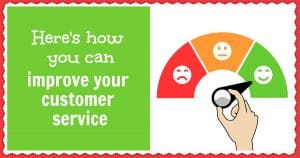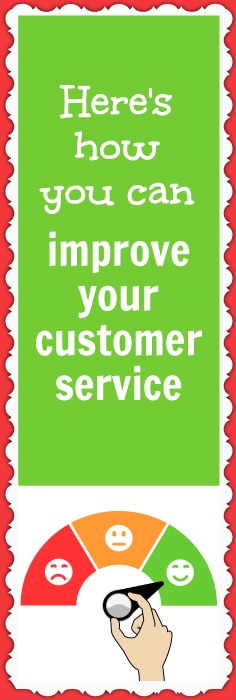High-quality customer service is super important for your business. Without it, your customers’ issues may go unresolved or more damage may actually be done.
Providing great customer service is how you get repeat business and more word-of-mouth referrals. When people have a good experience with a business, they tell their friends.
Customer service comes more naturally to some people than to others, though.
Good customer service relies on the following personal characteristics:
- empathy – this involves putting yourself in other people’s shoes and treating them the way you’d want to be treated.
- patience – practice the golden rule here and remember that misunderstandings happen and not everyone is going to be on the same page about everything.
- consistency – you should provide the same level of high-quality service even when people are difficult.
- adaptability – each customer is different and customer moods can vary so you need to be able to adapt your communication accordingly.
- clarity – communication needs to be as clear and straightforward as possible.
- punctuality – you should respond to customers in a timely manner (always aim for within 24 hours).
- thick skin – customers may be rude or downright mean, but as much as you might want to respond in turn (and even if you’d be totally justified in doing so), for the sake of your business’ reputation, you need to take the high road.
Whether or not good customer service comes naturally to you, below you’ll find nine ways to make your customer service even better by making your customers feel cared for, heard, and valued.
Let’s dive in…
Engage in active listening
Practicing active listening is the best way to provide excellent customer service, making your customers feel heard and cared for. Active listening involves putting aside your ego and immersing yourself in what your customers are saying so you can figure out the best solutions possible.
Here are a few tips for practicing active listening with your customers:
- If there’s any doubt about the issue at hand, rephrase or clarify what your customers have said in the form of a question so they can either confirm or further explain.
- Empathize and reflect back what customers say to you. For example, you might say, “Having your order arrive later than expected is frustrating. I understand why you’re upset.”
- Act as a sounding board first and foremost.
- Remain open, neutral, and judgment-free as much as possible.
Active listening is a skill that needs to be practiced and cultivated over time. And it can be especially challenging to listen in this way when customers are heated or angry with you.
The good thing is, though, if you do LHS, most of your customer service interactions likely take place over email. So if you find yourself feeling heated or angry or defensive in response to what your customer is saying, take a step back and take a breath before re-reading and responding to the message.
Remember, we’ve all had less-than-ideal experiences with products we’ve ordered or companies we’ve done business with. Think about how you’d want to be treated if you were in your customers’ shoes and respond in kind.
Identify common ground or shared interests with customers
This won’t always be apparent, especially not if it’s the first time you’re interacting with a person. But, over time, you may get to know people better. And even if it is your first interaction with someone, you can often find clues about their likes and interests in their message.
Say, for example, someone writes in about an issue with a mug featuring a cat design on it. Of course, that doesn’t necessarily mean the person loves cats, but it might. So you could start your response off by saying something like…
“As a fellow animal lover, I understand your frustration…”
Similarly, if you can deduce where someone lives, you could mention something about how you’ve wanted to visit there or how you once took a trip there (if you really did).
There are all kinds of ways to connect with people and find common ground if you pay attention. And even if you can’t find any specific interests or common ground to bond over, you can connect over whatever the issue might be that the person is contacting you about. For example…
“I feel frustrated when my orders don’t arrive on time too, so I totally get where you’re coming from…”
Finding common ground — whatever way you can — makes it easier to resolve issues because it humanizes the interaction and endears you to your customers and vice versa.
Be transparent and admit your mistakes (even before customers notice)
This is important. People really value transparency. And making a mistake doesn’t mean you’re a failure or your business is terrible. It just means you’re human and your business is run by a human. :-)
You obviously want your business to run as smoothly as possible. But mistakes are going to happen. They’re inevitable, especially during busier times of the year. And the best way to handle mistakes is to be open and honest instead of acting defensive or deflecting blame.
More often than not, your customers will be the ones contacting you about mistakes or issue. But sometimes, you might discover an issue before your customer notices.
For example, you might notice that a customer paid for expedited shipping, but the tracking number indicates the product will arrive later. Instead of sitting back and just hoping the customer won’t be upset or reach out, you should contact the customer yourself and apologize in advance for the delay and offer to refund their shipping expenses.
This makes customers feel taken care of and lets them know you’re looking out for them even when things don’t go as planned. Some customers will, of course, still feel upset, but others will be understanding and appreciative that you took initiative and were transparent about the situation.
Record video responses
You don’t have to do this as a rule. But some issues that customers write in about could be answered more clearly or thoroughly with a video.
For example, sometimes customers could benefit from a screencast showing them exactly where to click or what steps are involved with the response to their issue.
Recording video responses can also be a time-saver for you, especially if an issue requires a lengthier response. It’s usually faster to record yourself speaking than it is to type everything out and proofread. Plus, video responses feel more personal.
So anytime you think a response could be enhanced with a video, consider using Jing (it’s free) to record what you’re saying as well as what’s happening on your computer screen.
Send a follow-up message after a problem has been resolved
This is another way to show customers you really care and are willing to go the extra mile to make sure they’re satisfied.
One to two days after an issue has been resolved, send your customer a follow-up email saying something like…
Hey [first name],
I just wanted to follow up to see if there was anything else that I could assist you with or if you had any additional questions. If not, please feel free to disregard this message. But if so, please respond and I will do whatever I can to make sure you’re satisfied.
Thank you!
Best,
[your name]
You might also send customers a feedback survey, which you can create using SurveyMonkey. The survey might ask…
How satisfied are you with the service you received?
- Very satisfied
- Satisfied
- Unsatisfied
- Very unsatisfied
What can I do to improve your experience?
_____________________________
Use your customers’ name
Addressing customers by their first name is a friendlier approach than using a greeting such as “Hey” or “Hello” by itself. And personal touches such as this lead to more humanized, less generic interactions, which customers appreciate.
It all goes back to making customers feel like you genuinely care, so a sense of trust can be established.
Offer self-help options
You likely encounter similar questions and concerns from different customers, in which case it’s useful to add a FAQ section, document, or page on your shops where possible or your website, including your responses to commonly mentioned questions and concerns.
Having a FAQ attached to your business can cut down on the number of customer service requests you get in the first place. Customers who visit your shop can see the FAQ, review it, and hopefully find the answers they need.
Not everyone will notice your FAQ, however. So another thing you can do is include a link to your FAQ in each of your customer service messages. Your FAQ won’t necessarily address the issue at hand, but you’ll be putting it out there should customers have any questions or issues in the future.
And, of course, some people just prefer going through the customer service process over reading a FAQ, but including a link to additional information certainly can’t hurt the interaction (as long as you don’t rely on the link alone to suffice as your response).
Encourage customers to contact you
It’s better for customers to speak to you directly about their issues and concerns than for them to voice them publicly via social media or as negative reviews. So you need to make sure customers have an easy outlet to do so.
Make sure your contact info is readily available on your shops and wherever else it makes sense. For example, if you have a Facebook fan page for your business, in your About section, you can encourage customers to either email you or use Facebook messenger to get in touch with any questions or concerns.
Then, just be mindful that you closely monitor all of your contact channels and make every effort to respond in 24 hours or less.
Ask for feedback from time to time
You don’t have to wait for customers to contact you with feedback. You can be proactive about it and reach out to them every so often, asking for feedback about how you and your business are doing in their opinion.
You can create a survey with SurveyMonkey and email it out or post it on social media. Another option is to create a poll and add it to your Instagram Story.
Asking for feedback in this way lets customers know you care about them and want to make your business as great as possible. You can ask questions like…
- What types of designs would you like to see more of?
- Would you recommend my business to a friend? Why or why not?
- What can I do to improve your shopping experience?
- If you’ve ever had to contact me about an issue, was the matter resolved to your satisfaction? If not, how could your customer service experience have been improved?
Basically, you want to learn from your customers about any points of friction that exist as well as what they think you’re doing right. As the business owner, you may have blind spots about the ways in which your business can improve. Asking customers for feedback can give you a fresh perspective about your products and business and open your eyes to issues you may not otherwise have considered.
Do you have any other tips about how to improve customer service? Please leave a comment below and share your insights. Also, if you liked this post, please share it with your friends and followers!






0 thoughts on “Here’s how you can improve your customer service”
Thanks for the HELPFUL tips. Customer Service is probably the most overlooked training in most businesses on and off line. You know when you get it…and you REMember it. The surest way to get unpaid advertising. Just do the right thing and be the first to respond